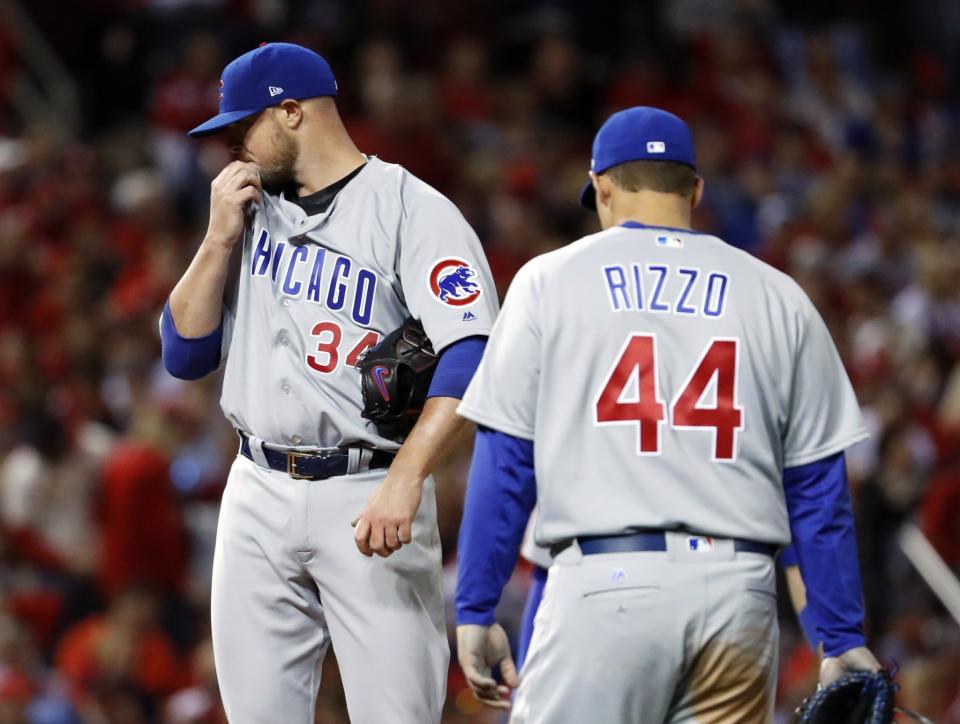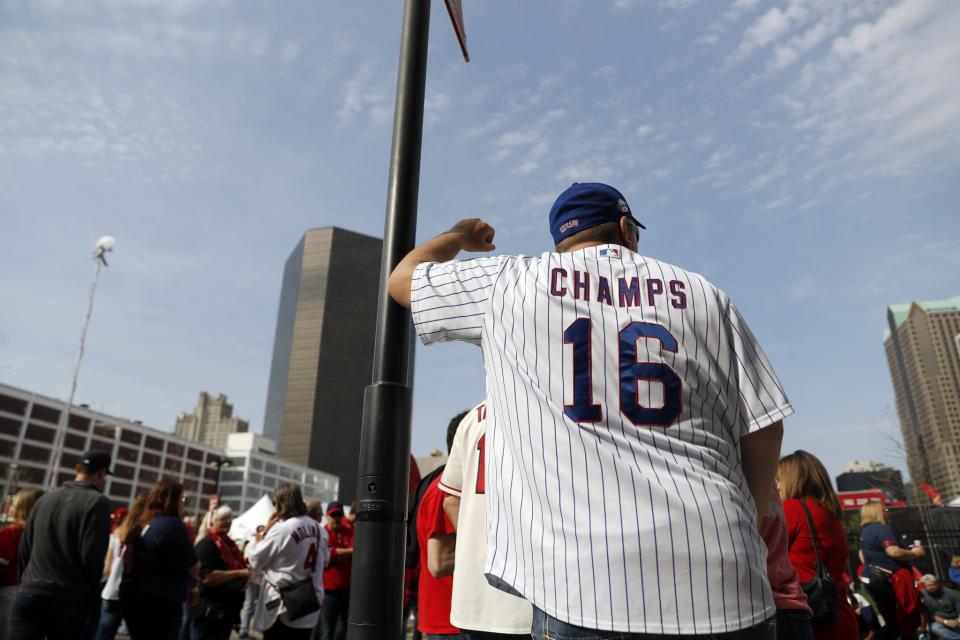The Cubs want to build a dynasty, and they have the players to do it
ST. LOUIS – About an hour before the first game of the rest of the Chicago Cubs’ lives, Tom Ricketts stood on the field at Busch Stadium and couldn’t help but dream big. It’s easy, in the afterglow of the Cubs winning their first World Series in 108 years, to get ensnared in fantasies of what may be. And yet Ricketts, the Cubs’ owner, a fan deep down, cannot help but ride the euphoria of last October into visions of grandeur.
“This,” Ricketts told Yahoo Sports, “could be one of the more compelling teams of all time.”
Lest this sound like an exaggeration, one need only look at the lineup the Cubs proffered Sunday night, as they opened the defense of their championship against the St. Louis Cardinals. Top to bottom, front to back, the Cubs’ lineup is one big Ghostface. It only reinforced the reality that as the 2017 season dawns, with three games Sunday and another dozen Monday, the Cubs, and their desire to turn one magical year dynastic, have grown no less fascinating on account of their new jewelry.
Take the game Sunday. The Cubs lost, 4-3, on a bases-loaded, walk-off gapper from Randal Grichuk. St. Louis celebrated with the sort of glee other teams will take in vanquishing the Cubs over the next 161 games. Nobody inside the Cubs’ clubhouse wore a sorry face – not because they didn’t care but because what they’d seen a few minutes earlier gave them reason to feel plenty good.
With one out in the ninth inning, Willson Contreras, their precocious catcher, launched a three-run home run off Seung-hwan Oh, the Cardinals’ closer off of whom batters hit .190 last year. Stifled for seven innings by the great Carlos Martinez, stunted in the eighth by Oh, the Cubs roared back behind a 24-year-old with immense power, an arm to match and something every bit as appealing as those two tools: another six years of both at depressed prices.

The Cubs control Contreras’ rights through the 2022 season, after which he’ll hit free agency. Teams spend tens of millions of dollars annually trying to develop one player like Contreras. The Cubs have a lineup of them. Kris Bryant won the National League MVP last year. He’s controlled through 2021. Kyle Schwarber may well be one of the best hitters in baseball this season. He’s through 2021, too. Same goes for shortstop Addison Russell and second baseman Javier Baez, the league’s most athletic middle infield. And that’s to say nothing of first baseman Anthony Rizzo, a perpetual MVP candidate, and Jon Lester and Kyle Hendricks, second and third, respectively, in 2016 NL Cy Young voting, all three of whom are Cubs through 2020. It makes the prospective free agency of starters Jake Arrieta and John Lackey after this season that much more palatable.
Want to know why Tom Ricketts says this can be one of the most compelling teams of all time? Because it can. And because, Ricketts said, he’s committed to partnering with team president Theo Epstein to ensure it stays that way.
“A lot of these guys are locked in for a few years,” Ricketts said. “We’ll give it to Theo to make sure we have the right mix of players in the future, too. It comes down to how much revenue we have. We’ve got a bunch of other expenses, but I think that won’t be a problem for us. I think we’ll put a good team on the field and be able to maintain roughly our current spending levels – maybe even go up a little over time. We’ll be right in the mix. It won’t be a money issue.”
It’s impossible to overstate the surplus value the Cubs reap from their current roster. Lester – and Jason Heyward, whom they signed to a $184 million deal that runs through 2023 – are the only players locked into long-term contracts at market value. Even though Bryant, Russell and Hendricks hit arbitration after this season, they’ll still make a fraction of what they produce, and that will go even as the system offers them significant raises leading up to free agency.
The incentive, then, is to keep them, and because the Cubs have the resources to do so, conjuring notions of multiple championships – and perhaps even the first back-to-back World Series titles since the New York Yankees won three in a row between 1998 and 2000 – is far from delusional. No team since has found its short- and long-term goals so aligned.
“Iconic franchises having runs of being very, very competitive in all sports is a good thing for the sport,” said commissioner Rob Manfred, who took in Sunday night’s game. “I think the Yankees’ run in the late ’90s, early 2000s was good for the sport. I think the Cardinals’ run [of two championships in six years], good for the sport. When you have an iconic franchise, it can be a good thing.”
Should the Cubs win again, it won’t be the same, of course, as 2016’s championship. That’s not the point. In the Cubs, baseball has been gifted a young, fun, likeable, interesting team that happens to play a delicious brand of baseball, with superlative fielding backing solid pitching buttressed by a lineup that to pitchers feels like firewalking, in which they try to traverse it as quickly as possible without getting burned.
“You’ve got 30-home run potential,” Lester said, “if not 40-home run potential, from your left fielder, shortstop, third baseman and first baseman.”
He paused, realizing he’d left out a few.
“And your catcher. And your second baseman,” he said. “We have problems with playing guys enough.”
It manifested itself Sunday, when Heyward played out of position in center field to give Baez and the ever-steady Ben Zobrist slots in the opening night lineup. On the bench sat Albert Almora Jr., their best center fielder – controlled through 2022 – and Jon Jay, another center fielder they signed this offseason. If the worst thing facing the Cubs in 2017 is they have too many good players, baseball has its own version of a first-world problem.
“If these guys stay healthy and focus on what they have to accomplish to make it through a whole season,” Ricketts said, “it could be a lot of fun for years to come.”
All the excitement can run headlong into the brick wall that is October. Series are short. Slumps happen. No matter how much better the Cubs are than the rest of baseball during the regular season, the playoffs leave them vulnerable. In the postseason, variance often trumps greatness.
Another factor working against the Cubs just as much as, if not more than, the crapshoot that is the season’s final month: the game’s information revolution. The industry-wide shift toward objective analysis left teams with an almost-across-the-board valuation put on players. Accordingly, roster constructions in baseball – not to mention teaching methods and player-development plans – have trended toward homogeneity. Not every team thinks the same. They think close enough, though, to punish only the most active tankers with dreadful records.

This, Lester said, matters deeply during playoff pushes, and it leaves him – one of the most vociferous Cubs advocates who put his money where his mouth was by signing with them after five straight miserable seasons – not quite as sanguine as Ricketts about an extended reign.
“You’re not going to be the ’96 to 2000 Yankees,” Lester said. “I think it’s a different era. Yeah, I think this team has as good a chance as any to win the World Series. But if you look around the American League and National League, teams are just so much better from top to bottom. Look at the trade deadline. Who traded people?
“You don’t see people moving. You don’t see the top two teams and bottom three teams in divisions anymore dominating and sucking. Everybody is competitive. I feel like for us to get back to the playoffs would be a win, and when you get back there, you just try to survive.”
Absent a rash of injuries – and this is baseball, so avoiding that for another year would be rare – survival is the least the Cubs will do. They showed those skills during the World Series last year, shaking off a Cleveland Indians team dead set on turning the Cubs’ drought into 109 years. This is the fun part: doing it again.
“If our pitching staff stays healthy and our bullpen stays healthy …” Lester said, trailing off, allowing someone else to fill in the blank. Here’s the right answer: They’ll be tough to beat. They’ll be the favorites, again. They’ll have that opportunity to be even more compelling.
Six long, hard months stand between. They’ll have nights like Sunday, when Baez missed a double-play groundball because it was camouflaged by white signage against the backstop, when they frittered away Contreras’ huge home run, when baseball’s fundamental truth – even the best teams lose a lot – served as a reminder that dynasties aren’t easy.
They’ll try anyway, and they should, because these Chicago Cubs’ ambition is matched by perhaps only one thing: their talent.
More MLB coverage from Yahoo Sports:


